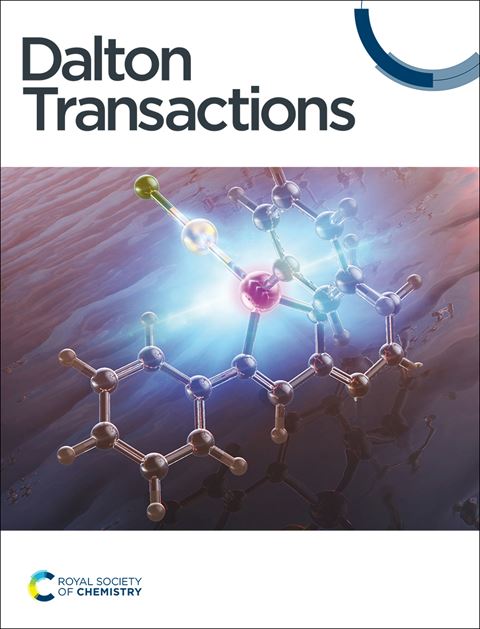Heterometallic CuCd and Cu2Zn complexes with o-vanillin and its Schiff-base derivative: slow magnetic relaxation and catalytic activity associated with Cu(II) centres
IF 3.5
3区 化学
Q2 CHEMISTRY, INORGANIC & NUCLEAR
引用次数: 0
Abstract
In this work, two novel heterometallic mixed-ligand mixed-anion complexes [CuIICdIIClL(o-Van)(OAc)]·3H2O (1) and [CuII2ZnIICl2L2(o-Van)(OAc)] (2) were prepared by reacting fine copper powder and Cd(II) or Zn(II) acetate with an ethanol solution of the Schiff-base ligand HL formed in situ in the condensation reaction of 2-hydroxy-3-methoxy-benzaldehyde (o-VanH) and CH3NH2·HCl. The compounds were thoroughly characterized by elemental analysis, FT-IR, UV/Vis and EPR spectroscopy, cyclic voltammetry, and single-crystal X-ray diffraction, revealing the neutral molecular nature of both the compounds. Catalytic properties of 1 and 2 were studied in the oxidation of hydrocarbons with H2O2 under mild conditions, showing the maximum reaction rate of 4 × 10−5 M s−1 and TOF up to 640 h−1. Both compounds undergo complex transformations in solution as evidenced by kinetic analysis and time-dependent UV/Vis spectroscopy, indicating that the reduced Cu(I) form of 1 is unexpectedly unfavorable. Complex 1 demonstrates slow magnetic relaxation dominated by the direct relaxation process between T = 1.8 and 7 K under an external DC field of 0.2 and 0.4 T, a very rarely observable effect in the coordination compounds of Cu(II). Complex 2 possesses weak ferromagnetism (J = 4.50 cm−1, zJ′ = −0.201 cm−1 for H = −JS1S2 formalism) occurring through the Cu–O–Cu pathways. Theoretical CASSCF, DFT and TDDFT calculations were applied to investigate the electronic structures of 1 and 2 and rationalize their behavior in solution.

在这项工作中、制备了两种新型杂金属混合配体混合阴离子配合物 [CuIICdIIClL(o-Van)(OAc)]-3H2O (1) 和 [CuII2ZnIICl2L2(o-Van)(OAc)] (2)。碱配体 HL 的乙醇溶液进行反应,该配体是在 2-hydroxy-3-methoxy-benzaldehyde (o-VanH) 和 CH3NH2-HCl 的缩合反应中就地形成的。通过元素分析、傅立叶变换红外光谱、紫外/可见光光谱和紫外-可见光光谱、循环伏安法和单晶 X 射线衍射法对化合物进行了全面的表征,揭示了这两种化合物的中性分子性质。在温和条件下,研究了 1 和 2 与 H2O2 氧化碳氢化合物的催化特性,结果表明最大反应速率为 4 × 10-5 M s-1,TOF 高达 640 h-1。动力学分析和随时间变化的紫外/可见光谱显示,这两种化合物在溶液中都发生了复杂的转变,这表明 1 的还原型 Cu(I) 是意想不到的不利形式。在 0.2 和 0.4 T 的外部直流电场作用下,络合物 1 在 T = 1.8 和 7 K 之间表现出缓慢的磁弛豫,这种直接弛豫过程在 Cu(II)的配位化合物中很少见。配合物 2 具有微弱的铁磁性(J = 4.50 cm-1,zJ′ = -0.201 cm-1,H = -JS1S2 形式),通过 Cu-O-Cu 途径产生。理论 CASSCF、DFT 和 TDDFT 计算用于研究 1 和 2 的电子结构,并合理解释它们在溶液中的行为。
本文章由计算机程序翻译,如有差异,请以英文原文为准。
求助全文
约1分钟内获得全文
求助全文
来源期刊

Dalton Transactions
化学-无机化学与核化学
CiteScore
6.60
自引率
7.50%
发文量
1832
审稿时长
1.5 months
期刊介绍:
Dalton Transactions is a journal for all areas of inorganic chemistry, which encompasses the organometallic, bioinorganic and materials chemistry of the elements, with applications including synthesis, catalysis, energy conversion/storage, electrical devices and medicine. Dalton Transactions welcomes high-quality, original submissions in all of these areas and more, where the advancement of knowledge in inorganic chemistry is significant.
 求助内容:
求助内容: 应助结果提醒方式:
应助结果提醒方式:


